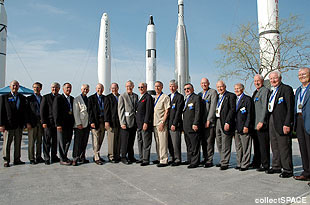May 2, 2005 — Three veteran astronauts – early test pilot Gordon Fullerton and spacewalkers Joe Allen and Bruce McCandless, were enshrined Saturday into the Astronaut Hall of Fame during a public ceremony hosted at NASA's Kennedy Space Center in Florida. The trio comprises the fourth class of Space Shuttle veterans to be inducted into the Hall since 2001 and increased the total number to 60 of astronauts recognized since the first induction in 1990.
With two flights each to their name, this year's inductees were chosen for their roles qualifying the shuttle for flight and for pioneering the use of a jet backpack for working and moving in space. The three were nominated by their peers and colleagues, historians, reporters and teachers.

Fifteen Astronaut Hall of Fame enshrinees reunited at Kennedy Space Center to welcome the fourth class of shuttle inductees. |
Joining them on Saturday's stage were 15 of their fellow enshrinees – including moonwalker John Young, Mercury original Scott Carpenter and Apollo 13's Jim Lovell. They were introduced by emcee Levar Burton, an actor known for his role on Star Trek, and draped with medals by their former crew mates.
From the Moon to the Earth to the Moon, again
Though this weekend's three honorees made their first and subsequent flights aboard the shuttle, they all joined NASA's astronaut corps during the Apollo program. They served on ground-based support crews for the manned lunar landings years before later launching for Earth orbit themselves.
"Its nice to be recognized for what was the highlight of my life for 17 years, first during Apollo and then having a chance to work on the Space Shuttle," said Fullerton in an interview with collectSPACE.
Selected for the Air Force Manned Orbiting Laboratory before transferring to NASA, Fullerton flew two shuttle flights in space and before them, five captive and free approach and landing tests with the shuttle Enterprise. He piloted the third flight of the shuttle Columbia, testing the robotic arm, and landing the first and only time at White Sands, New Mexico due to wet conditions at Edwards Air Force Base. Six minutes into Fullerton's second mission STS-51F, which he commanded, a premature engine shutdown forced the only abort in Space Shuttle history on an otherwise routine Spacelab science-focused flight.
During his career as an astronaut, Fullerton saw capsule- based spacecraft reach for the Moon and then helped develop the winged shuttle to ultimately build and service an Earth orbit-based space station. Now that focus has returned to the Moon and capsules for the missions after the shuttle has been retired, Fullerton is not clear yet if it will be a step forward or back.
"It bothers me a little that the [Crew Exploration Vehicle] is not yet firm on what it can do," says Fullerton, who still flies aircraft for NASA Dryden Research Center.
Repair in space
Another of this year's inductees, Joe Allen also ponders the future of flight, though in the shorter term as it applies to the Space Shuttle's upcoming resumption of service.
Allen flew to space twice, on missions STS-5 in 1982, and STS-51A in 1984. His rookie flight, the shuttle's first operational mission, deployed two satellites. His second mission featured the world's first space salvage. Using the jet backpack first tested by McCandless, Allen and his crew mate Dale Gardner captured two malfunctioning satellites. While Gardner worked to prepare for berthing in the payload bay, Allen held the half-ton spacecraft steady above the orbiter for 90 minutes.
Though he admits he is not an engineer – he rather looks at things with the "simplicity of a physicist" – Allen, as one of the first astronaut repairmen, cautions that the attention placed post-Columbia on heat shield tile repair methods may be too narrowly focusing on the problem.
"The way we safeguard commercial airliners, is not by issuing all the passengers parachutes," observes Allen. "The wings are built not to fall off."
"The Space Shuttle must be reconfigured so that debris does not strike the leading edge. [NASA has] made changes and if they are successful, then you don't need repair methods."
Hopes for Hubble
That's not to say all repairs in space should be ruled out. For Bruce McCandless, the news from NASA of resumed work on a Hubble Space Telescope servicing mission is hopeful.
McCandless will be forever remembered by an iconic photograph taken of him flying freely – without tethers – over the Earth on mission STS-41B. During that flight, his first, McCandless tested the Manned Maneuvering Unit (MMU), a jet-powered backpack that allowed him to float away from the shuttle. Six years later, he launched to space aboard STS-31 / Discovery to deploy the Hubble Space Telescope.
"I am a proponent for extending the Hubble Telescope's use to until the James Webb Space Telescope (JWST) is launched and confirmed as operating," said McCandless to collectSPACE. "I support either a manned or robotic approach." McCandless hopes that that the future shuttle mission can combine the two by flying a robotic payload that would assist the astronauts in between spacewalks.
Astronaut artifacts
As newly inducted members, Fullerton's, Allen's and McCandless' etched-glass portraits are now hanging in the Titusville, Florida Astronaut Hall of Fame, alongside artifacts from its many enshrinees. The three will also have an opportunity to display items from their career.
Though Allen says he has little in his possession to donate, he hopes to work with the Smithsonian to locate the "jousting lance" attached to his MMU that was used to salvage the two satellites on his second mission.
McCandless, who now is chief scientist with Lockheed Martin's Advanced Space Transportation office, plans to have on loan the company's replica of the Collier Trophy that was awarded to Martin Marietta for the development of the astronaut MMU jetpack.
Fullerton has a few ideas as to what he might donate but is unsure what regulations apply given his still active role at NASA.
